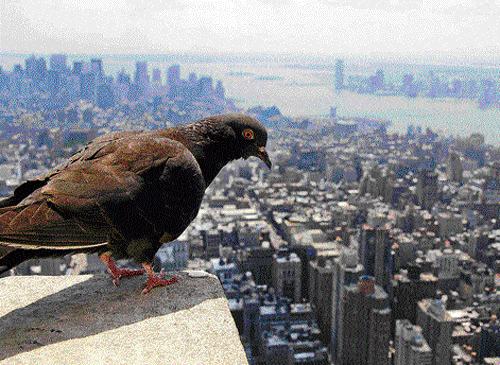
As cities expand and humans encroach upon animal habitats, the creatures have no other option but to adapt to the changing environment in order to survive. We may be fuelling the evolution of bigger brains in city-dwelling animals, writes Atula Gupta
Away from the open pastures, green valleys and forested pathways, a village simpleton new to the city soon realises the first bitter lesson of survival. Become a little selfish, a little sly if you want to live and earn your daily bread. But does the same lesson apply for animals too? Interestingly, scientists from University of Minnesota have found it does.
Animals living in the city, from pigeons to crows and from badgers to jackals, are adapting to these changes and the ones that are successfully surviving in the concrete jungle are brainier than their naïve rural counterparts.
Researchers believe humans are creating all these totally new environments compared to what the animals have seen in evolutionary history. These urban jungles filled with highways, vehicles, soot, dust and a multitude of concrete buildings are not variations of an old habitat but a new habitat, where Darwin’s lesson of survival of the fittest still holds true.
Therefore, besides crows that have highly adapted to living in different habitats and have for long made cities their home, there are also racoons, rats, jackals, sparrows, hornbills and even leopards that have slowly begun to realise that the old world has changed forever and it is the new age concrete jungle where they need to learn to live if they want a future for their species.
In the study conducted, researchers compared the brain size of museum specimens gathered across the 20th Century in Minnesota, USA, with that of rural mammals and found a jump in brain size of the city dwellers. This was observed in shrews, voles, bats, squirrels, mice and gophers. They believe it is because of the cognitive demands of adjusting to changing food sources, threats and landscapes. Therefore, just like humans who live in cities rather than in rural areas tend to be more street-smart, city dwelling animals too become cleverer than their rural counterparts.
Although brain size does not relate to the intelligence of a human or any animal, the pattern of increase in brain size in all the mammals observed by the team, does show there is some relation to their living in an urban environment and thus needing more grey matter to survive.
But is becoming smarter the only adaptation that animals have to make in cities? No, find many previous researches. When Catarina Miranda of Germany’s Max Planck Institute compared rural and urban blackbirds, she found avoiding danger a useful trait for some animals living in urban environments. Urban birds, she observed, never approach new objects or enter new environments easily. She explains that in cities, birds know there are many dangers like a vehicle running over them, a kid jumping at them and catching them, therefore they learn to avoid these dangers by becoming less curious of new settings.
Jason Munshi-South, an evolutionary biologist at the City University of New York studied city salamanders with those living in the wild and found that, “[They] tend to be languid.”
“If you try to pick them up, they don’t try to escape as vigorously as they do outside the city. I wonder if there’s been natural selection for that,” said Munshi-South.
Therefore, city species are smarter, but are more careful too and less aggressive than their wild cousins. Observe a monkey used to living in a human settlement and one in a forest. You will easily find how the city macaque is attuned to all the chaos surrounding him, while its wild cousin will grit its teeth in anger or shy away if you try to approach it. Muted stress response is a sensible-seeming adaptation. A rat that gets anxious every time a subway train rolls past won’t be very successful.
The question arises though whether these changes occurring in city animals are a permanent biological modification passed from one generation to the next or an adaptation to circumstances that can be forgotten once they are back in the wilderness.
Experts believe that while some adaptations are passed on from one generation to another, others can be modified. Biologist Atwell found that urban birds sing at a higher frequency than rural birds. But when he raised a few of the chicks in a quieter place without the loud noise of a city life, their singing frequency dropped too. What is interesting is that even if these are just adaptations, sometimes what one individual learns, is quickly copied by others of its clan. Urban squirrels, for example, seem to have adjusted to vocalisation-drowning ambient noise by making tail-waving a routine part of communications. Perhaps this was instinctive in a few animals, then picked up by others. So, there is also a culture evolution observed in city-bred animals besides changes at the individual level.
There are many questions that in turn surface from these studies. Does the change in character or brain functioning of an animal eventually give rise to a different subspecies that is more adept to city living? Can the Asian macaques that now live so well amongst us in cities survive now if they are given the freedom to live in a wild environment again? And the big question – is this evolution beneficial or harmful for the species and the natural life in general?
Evolution is a change over time and the answer to all these questions lies in the future when multiple generations have been observed and seen to survive the man-made changes brought into this world. While conservationists might disagree and even repent the forced modifications in an animal’s natural lifestyle, if the adaptations are necessary for the sheer existence of these species, it might as well be a good change that is happening.
Deccan Herald is on WhatsApp Channels| Join now for Breaking News & Editor's Picks